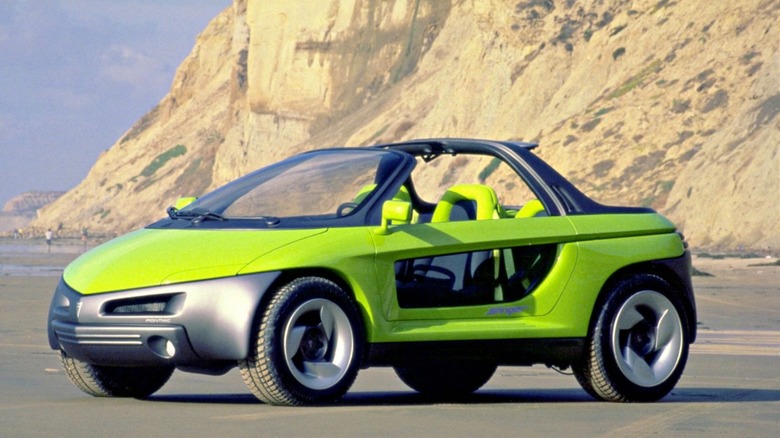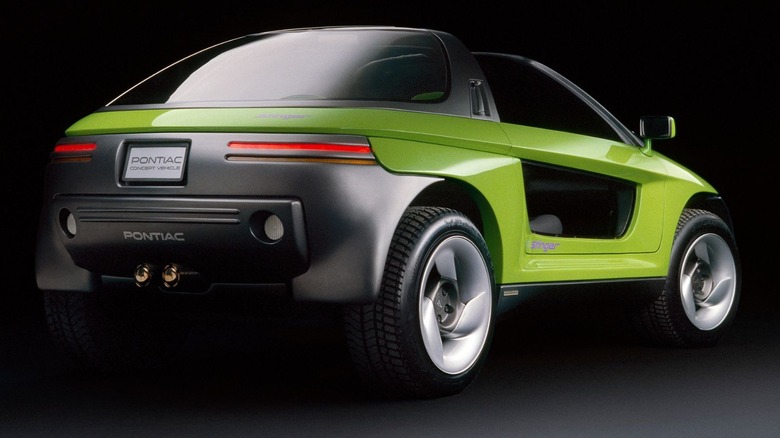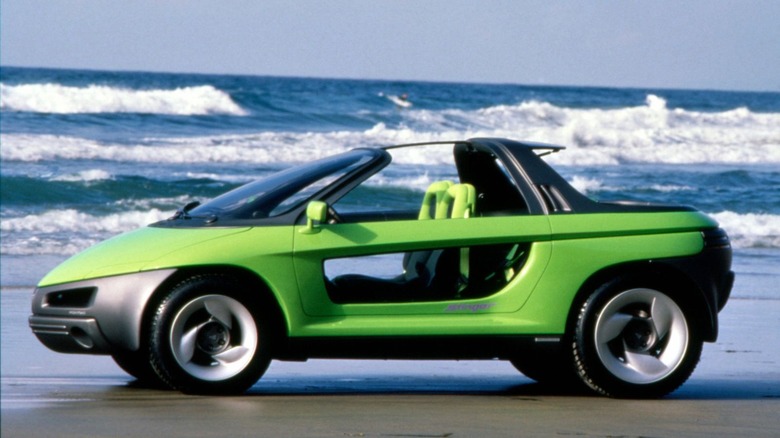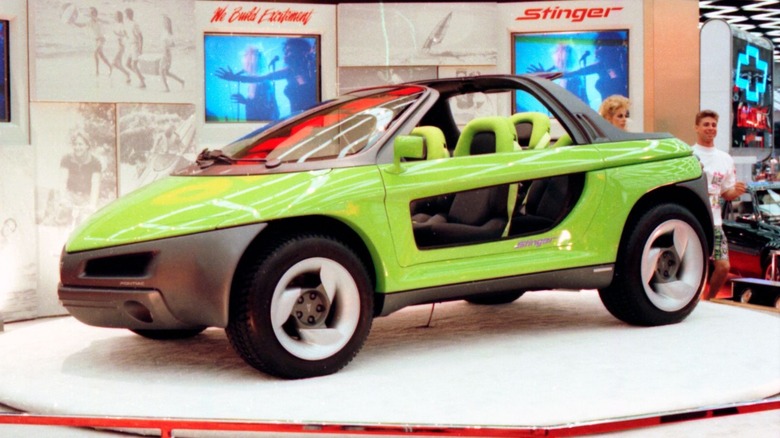The Stinger: A Radical Concept That Pontiac Should've Bet On
If James Bond had suddenly given up his life as an international man of mystery and started living the California beach life in the 1980s, he'd have immediately swapped out the Aston Martin V8 Vantage Volante for Pontiac's Stinger. The green and black car oozes Timothy Dalton's more theatrical style, but it's what's inside that reeks of Bond's signature hidden gadgetry. Unfortunately, Dalton never did get to explore beach bum Bond and Pontiac never put the Stinger into production.
First introduced at the 1989 Detroit Auto Show, the 1989 Pontiac Stinger turned heads with its vibrant green exterior, black accents, and uniquely sporty shape. At first glance, it looked like the type of ride you'd cruise along Pacific Coast Highway in, soaking in those beautiful ocean views and breathing in fresh salty air. It was a vision, for sure, and quite possibly part of what Pontiac had in mind when it stockpiled the Stinger with a bounty of removable features, accessories, and so much more.
A fascinating non-entry in Pontiac's extensive line of vehicles, the Stinger simply wasn't something execs were willing to bet on for the 1980s United States. However, with its modular accessories, open-air concept, and an assortment of other sporty features, passing on production seems more and more like a complete misstep.
The birth and death of the Pontiac Stinger
As Pontiac found while researching trends of the '80s, consumers were living sportier lifestyles. In a 1989 statement, the director of market and product planning, Ed Benson, confirmed what the internal research had uncovered. "There is an emerging interest in the young group for sport vehicles that fully express their active lifestyles," he said, ultimately noting that Pontiac knew the direction it needed to go. The 1989 Stinger was the product, a sport utility vehicle to rival moves being made by Jeep and Dodge to satisfy that market.
The concept for the Stinger came from General Motors' Advance Concept Center in California and stood out as one of several wildly ambitious ideas from which Pontiac eventually strayed. Though neither Pontiac nor GM ever confirmed why the Stinger was passed up, it's fairly easy to make a few guesses. The modular design and impressive level of accessories (which we'll get to shortly) would likely become an engineering nightmare in a production vehicle.
Along with five sizable removable glass panels that drivers would need to store, including two lower panels on each door and the rear windshield, GM had to properly stow and secure each add-on and gadget in such a way that they could never become a danger to the driver. Add that to the 15-inch height adjustment that allowed rear passengers to peer over the rollbar, and you have a vehicle destined for a future of lawsuits.
Pontiac doubled down on accessories
Despite the pitfalls of the Stinger's overall design, it's difficult not to feel a little like consumers would have eaten production models up. Beyond even the open-air concept that lends to an unimpeded sense of freedom, the Stinger was stocked full of items designed to keep drivers out and about, hiking through trails and splashing on the coast. Going through the full list of additional items stored in the concept car sounds more like reading off a shopping list for a trip to REI.
Scattered all throughout the vehicle were fun gadgets like a portable radio and more practical devices like a flashlight. The list continues on with the interior housing a portable vacuum, a sewing kit, binoculars, magnifying glass, tote bags, and a calculator. A first aid kit, essentials toolbox, extension cord, camp stove, fold-out camping table, and removable chair would allow more adventurous types to take the Stinger to the trails for a weekend campout. Forgot the sleeping bag? Don't worry because the Stinger's bucket seats lay back flat so you can comfortably stare out beyond the roof to the stars above.
Pontiac added everything from survival essentials to luxuries. The concept car didn't just astound with its treasure chest of gadgets. It also featured elements like seats made of wetsuit material to minimize damage by water. Of course, none of these additional features matter much if the car would slow-crawl across the country and completely disappoint with what's under the hood.
What was under the hood
For its sporty concept car, Pontiac opted for a four-cylinder, 3-liter inline engine capable of hitting 170 horsepower and a three-speed automatic transmission. Engineers chose a four-wheel drive powertrain, emphasizing that the car was designed to go off-road and take on the world. The carbon-fiber body supported this even further, as it lent to a lighter construction that could stand up to the elements and stand up to an active lifestyle. It was a punchy ride that would have been light on its feet at only 3,000 pounds.
For reference, in 2000, Pontiac released a sort of modern take on the Stinger's sporty focus. The Aztek only lasted for six production years, with stats that weren't much better than the 1989 concept car. Bumped up to a six-cylinder, 3.4-liter engine capable of 185 horsepower, the Aztek sported a four-speed transmission.
Though the Stinger favored off-roading with its four-wheel drive powertrain, the Aztek was a little more practical with an all-wheel drive system, albeit for a $2,000 upcharge. The Aztek also dropped all of the Stinger's fun accessories, though we can't ignore the tent that converts the sporty ride into a campsite and the plethora of storage for tailgating appliances — proving the Pontiac Aztek was a cool car.



